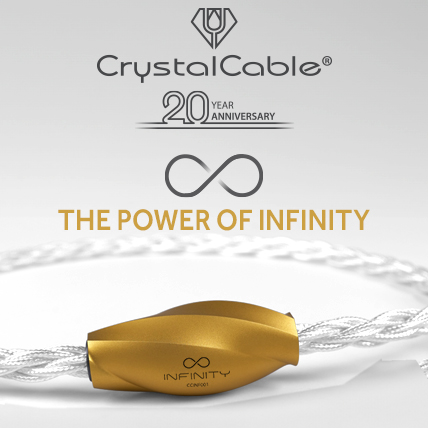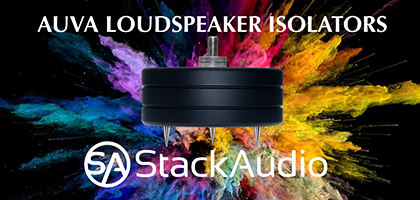No. 242 July 2024
- COVER REVIEW: Ferrum WANDLA GOLDENSOUND EDITION ⸜ digital-to-analog converter » POLAND
- AUDIO SHOW ⸜ coverage: HIGH END 2024 ⸜ Munich » GERMANY
- REVIEW: Daniel Hertz MARIA 350 ⸜ integrated amplifier » ITALY
- REVIEW: Lumin P1 MINI ⸜ file player » HONG KONG
- REVIEW: Thunder Melody AC FEMTO BLACK (2024) ⸜ AC power cable » POLAND
- REVIEW: Laiv HARMONY DAC ⸜ digital-to-analog converter » SIGAPORE
- MUSIC ⸜ review (in Polish): Three Blind Mice: KOSUKE, MOTOHIKO, YAMAMOTO ⸜ remaster 2024 • SACD/CD » JAPAN


|

|
|
THE FIRST TEN SECONDS 
That's a photo of the Rockport Technologies listening room. It's a large, acoustically treated space so the speaker need no, or almost no toe-in. As you can see only the amplifiers are placed between them – the rest of the setup is placed behind listeners (picture courtesy of Rockport Technologies). In the back one can spot a diffusor and at the side a mix of absorbing and diffusing elements.
The problem of assessing the sound quality is solved completely in the first 10-15 seconds of listening, at the intuition level. Any experienced listener knows that the first minute of listening is the most important one, and the rest is simply the time it takes to translate perception into words; It is only a matter of terminology and methods of communication.
Do you understand what that means? Well, so much that there is something in the sound, which constitutes its value, regardless of system's quality. An experience of a listener is an important factor, obviously, but the system itself reveals its most important secret, namely the fidelity to a live sound. This is fidelity defined as something primary, unstoppable, at least in the first stage. Only after this initial acceptance or rejection one can proceed to the actual assessment and description of the performance. I must admit that I fully agree with that. For years, in the Krakow Sonic Society we practice listening session using short, at most two minutes long music fragments, but I'm sure that even one minute is enough. A minute is four times longer than 15 seconds, but we also want to be able to say something about the sound. If it was only about yes/no assessment ¼ of the minute would surely be enough. Provided, let me repeat that, participants - in the words of Mr. Lamm – have proper "baggage" of knowledge. So that a set of devices became a system To make it work one particular condition has to be met: the system, we listen to, or we test new devices in, must be consistent, or coherent. Generally speaking, it should sound as a system and not a set of separate devices. I did explain the difference once before but it is worth reminding. 
My listening room, when I review products for „High Fidelity” and Positive-Feedback.com. As you can see the loudspeakers are significantly toed-in. The rack with the system is placed between speakers. The Dictionary of foreign words by PWN from 1980 says that the 'system' is an organized selection of elements, a set that creates a new wholeness conditioned by logical order of its components. The audio system would therefore be "coordinated system", "logically ordered" set of devices, products and audio accessories. Such a system must be internally consistent, ie. well-thought-through, with choices based on some particular idea or assumption. But while the ideas are great implementing them in the real live often proves difficult, so when we talk about 'the system' in the context of audio and high quality music playback we are usually thinking really about a 'set' - something a step down from a system. For a set of devices to became a system requires work - conceptual, ie. one needs to know what one is looking for, and also the very basic one, ie. a tiresome task of matching components finding an optimal way to achieve one's goal. It is important that there is no target price of a system, one might be looking for an integrated, all-in-one system with external loudspeakers, or an expensive set of components with each priced at 100 000 PLN or even more. After passing the first threshold, ie. after moving from a smartphone and headphones one receives with it to hi-fi, audio turns out to be an egalitarian club for all. At each price level one can build a satisfying system capable of moving, emotionally involving performance. Loudspeakers and what comes from them For this to work, few more basic requirements must be met and available funds properly distributed. One has to consider also individual elements of the system such as: the listener, room, amplifier, loudspeakers, source, cables, anti-vibration accessories, and some more. Among them, the most important is the listener, or his needs, requirements, financial resources, knowledge, and experience - both with the live sound, and with other systems. But equally important is the listening room, or in other words - acoustics. And then the placement of the loudspeakers in the room. 
The basic placement of loudspeakers in an equilateral triangle. The speakers are aimed directly at the listeners' ears. One should move the speakers away from the wall behind them, but should make sure that the distances were not the same, ie. the distance from the wall behind was different from the distance from the side walls. In terms of importance to the final effect these two elements' influence, it seems to me, might reach even 50%. It's a lot. I think most of the problems our readers approach me with result from bad acoustics and an erroneous setting of speakers in the room. The acoustics of the listening room is an extensive topic and we all keep learning something new about. However, in order not to leave you clueless I'll drop some advice that for some of you might seem obvious. First thing you should know that the worst possible room for listening is a square or close to square one. If you're in such unfortunate situation you might want to place your speakers asymmetrically, eg. at some angle to the walls so that the reflections from them and places where bass is amplified and damped were not obvious. If we have the rectangular room, try both variants of loudspeakers settings - ie. along the longer and the shorter wall. Most often the former one is better, when we ultimately sit closer to the speakers. The first variant gives you also a better control, because sitting closer to the loudspeakers means reducing impact of the reflected sound. It also requires bit more acoustic treatment. But it can be controlled by simple means - shelves of books and CDs, carpet, etc. For a long time it was thought that the best system is the DELE (dead end, live end), or placing sound absorbing elements behind the loudspeakers, and to equip part behind the listener with the diffusers. It's a good starting point, but experience shows that it is worth experimenting, and that is over-damping the room is much worse for sound than using to many diffusers 
A setting I use in the „High Fidelity” system, with loudspeakers strongly toed-in crossing in front of a listening spot. A part of this issue is the art of loudspeaker placement. Without going into the intricacies of it, it is worth mentioning that in every room we have to factor in some variables such as: distance from the wall behind speakers and from side walls, distance between speakers and from the listener. With the latter one comes one more variable – distance between listener and the wall behind him. |
The optimum situation is when the loudspeakers might be placed approx. 1 m from the wall behind them and are spaced apart at least 2 m. But it also depends on how they were designed. Some, for example, made by Audio Note UK should be placed against the wall. Also, a small stand mount speakers sound richer, more powerful when placed closer to the wall behind them. Aligning the speakers with the wall behind them degrades soundstage, especially its depth. There is no way around it and one needs to find the best balance between tonality and spacing of the presentation. But there is an easy way to significantly increase the depth of the soundstage. Just toe-in the speakers in such a way that their axes intersect in front of our head. I remember the extreme example of this technique, which during one of the High End Shows in Munich was presented by Mr. Ken Ishiwata, the Marantz brand ambassador. He set the speakers in such a way that their axes intersected 1 m, but not from us, but from the line connecting left and right speaker; they were actually almost "looking" straight at each other. The effect was phenomenal! Note that not all the loudspeakers will benefit from such setting – those with wide front baffles usually sound best directed at the listening spot. Toeing-in the loudspeakers has an additional advantage - it reduces reflections from the side walls, and also stabilizes images of instruments. Moreover, we are changing in this way the amount of treble. While moving speakers closer to the wall behind them increases the amount of bass, the toe-in minimizes treble presence. So if your systems sounds too bright you can change that using one of these two methods. Pylon Audio EMERALD „Touched by High Fidelity”: AUDIO TOUR DE POLOGNE 2017! 
It's just a small part of the problems one confronts when building an audio system. I think, however, that the loudspeakers are the most sensitive element, which one should devote the most attention to. Even more so that in this case the preferences of the designer and user/music lover, are more important than in the case of other components. So one should know what one looks for. But you should also make sure that you know what journalists look out for when testing audio products, because only then will you be able to match what you read to your personal expectations. For years, I had this discomfort that I was aware of it, but did not know how to solve this problem. So I regularly wrote articles in which I always mentioned my requirements and expectations, and I attached a list of reference components to every review. Nothing, however, could substitute a meeting with a real product face-to-face, listening to it, and later being able present personal impressions and findings. The problem was to find a company that would be ready for something like that. The guys from Pylon Audio were pretty enthusiastic towards my proposal and after two years the loudspeakers designed and build for the projects were ready (more HERE). Anyone could see them and listen to them during Audio Video Show 2016 in Warsaw, but the actual premiere happened several days earlier, in October 31st in a Krakow audio salon Audiotrendt. I run a workshop telling the story about the whole project, I pointed out some sound qualities we aimed at when creating these speakers, and most of all I played some music tracks discussing their qualities and story behind each of them. You can read more about it HERE This meeting resulted in a flow of emails coming directly to Pylon Audio to "High Fidelity", which clearly indicated that such meetings are needed. Therefore, we decided together that should present these loudspeakers to the widest possible group of music lovers and fans of good sound. Thus we have prepared four presentations that will take place in 2017, under the name of Audio Tour de Pologne 2017. 
Let me invite you for the first meeting that will take placed already on February 11th (Saturday) in Gdansk at Premium Sound premises at 12.00. The workshop will be divided into two parts, each of 45 minutes, with a 15-minute break in between. One should reserve approximately two hours for it. Next meetings:
We would like to talk with you, among other things, about the best ways to place loudspeakers in a room. This is the most neglected element in audio systems. We shall give participants some useful tips and tricks that might allow them to finally achieve their dreamed sound. We will also discuss the rules governing audio systems, the advantages and disadvantages of different types of amplifiers, as well as different audio cables. The most important, however, will be listening session. During the presentation I shall present the choices I follow when reviewing audio products, will point out the most important features of Emerald HF loudspeakers, and also talk about how techniques of sound recording, processing, and releasing. Participant will listen to not only well-known albums, but some absolute rarities. 
So, which one should it be – live or “canned”? All this would not make sense if we lived in a perfect world, where on demand would get a sound comparable to live performance. One of the axioms of our industry is the belief that it is possible to get closer to the point where it will be difficult to distinguish between real and reproduced sound. I believe that it will never really happen. The only thing we can do is try to follow that direction, but everyone has to do it in his own way. Searching for a proof that I can be right I found this short fragment of an interview with Mr. Kondo, conducted by the editor of the "Stereophile" magazine, Mr. Jonathan Scull (translated by Mr. Shibazaki). So let use it as a punch line for this article: Scull: If you're walking on the street and pass a window opened on a room in which musicians are playing, what is it that instantly tells you—without seeing anything—that it's live? WOJCIECH PACUŁA |
About Us |
We cooperate |
Patrons |
|
Our reviewers regularly contribute to “Enjoy the Music.com”, “Positive-Feedback.com”, “HiFiStatement.net” and “Hi-Fi Choice & Home Cinema. Edycja Polska” . "High Fidelity" is a monthly magazine dedicated to high quality sound. It has been published since May 1st, 2004. Up until October 2008, the magazine was called "High Fidelity OnLine", but since November 2008 it has been registered under the new title. "High Fidelity" is an online magazine, i.e. it is only published on the web. For the last few years it has been published both in Polish and in English. Thanks to our English section, the magazine has now a worldwide reach - statistics show that we have readers from almost every country in the world. Once a year, we prepare a printed edition of one of reviews published online. This unique, limited collector's edition is given to the visitors of the Audio Show in Warsaw, Poland, held in November of each year. For years, "High Fidelity" has been cooperating with other audio magazines, including “Enjoy the Music.com” and “Positive-Feedback.com” in the U.S. and “HiFiStatement.net” in Germany. Our reviews have also been published by “6moons.com”. You can contact any of our contributors by clicking his email address on our CONTACT page. |




 |
     |
main page | archive | contact | kts
© 2009 HighFidelity, design by PikselStudio,
projektowanie stron www: Indecity







 hile preparing materials for the Kondo Ongaku amplifier test, at one time the most expensive amp in the world, and still the most expensive integrated amplifier, my attention was caught by a brief statement of Mr. Vladimir Lamm. The journalist, conducting an interview with him, asked what should be a reference point while assessing audio system - the live sound, or comparison to other recordings and products. The answer was synthetic and it came down to appreciating both of these references, with an emphasis on live sound. What struck me most, however, came right after that:
hile preparing materials for the Kondo Ongaku amplifier test, at one time the most expensive amp in the world, and still the most expensive integrated amplifier, my attention was caught by a brief statement of Mr. Vladimir Lamm. The journalist, conducting an interview with him, asked what should be a reference point while assessing audio system - the live sound, or comparison to other recordings and products. The answer was synthetic and it came down to appreciating both of these references, with an emphasis on live sound. What struck me most, however, came right after that:


